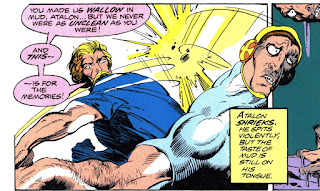Book Review: 'Software' by Rudy Rucker
'Software' (211 pp.) was published by Ace Books in January, 1982. The cover artist is uncredited. It's the first volume in the so-called 'Ware' series, followed by 'Wetware' (1988), 'Freeware' (1997), and 'Realware' (2000).
'Software' is set in 2020. The protagonist, 70 year-old robotics expert Cobb Anderson, is spending his retirement on the coast of Florida. In his younger days, Anderson was responsible for stimulating robots to evolve their intelligence according to Darwinian mechanisms. This in turn led to the development of sentience among the robots, and initiated a revolt of the automatons staffing a mining and construction facility on the Moon. The Moon now is a redoubt of robotkind, and while the robots are not overtly hostile towards humans, neither are they convinced that humanity deserves to inherit the universe.
Indeed, the Moon robots believe the world will be a better place once all of the human race are converted into androids, and emplaced within the consciousness of robotkind. Having developed what they believe is a successful technology for transferring a human's thoughts, memories, and personality - in other words, his or her 'software' - into an android body, the robots, in a demonstration of sentimentality, are interested in converting their creator, Cobb Anderson, into an android.
Anderson is intrigued by the idea of acquiring immortality through technology. But so doing will require travel to the Moon, where the robots are carefully vague about just how Anderson's personality and consciousness will be implanted in a android body. Will the reconstituted Anderson be solely a software construct, slaved to the commands of his robot saviors ? Or will Anderson the person persevere ?
For Anderson, time to decide his own fate is running out, for a policeman named Mooney has suspicions that a conspiracy is in the offing...........with Cobb Anderson a key element in its designs..........
'Software' was, for me, a dud. I'm not much of a fan of the genre of comedic sci-fi, which, more than cyberpunk, 'Software' belongs to. Had the novel been longer than 211 pages of large-font type, I might have given up on it at the half-way mark.
Like many comedic sci-fi novels, 'Software' relies on a breathlessly paced prose style, as if taking too long between gags might risk sinking the narrative. There is a reliance on cutesy mannerisms (one character is named 'Sta-Hi', another 'Haf-N-Haf'), one-liners, witty quotes, sarcastic comments, and Southern slang rendered phonetically (never a good sign).
The plot has a haphazard, throwaway quality, as if the author considered it simply a backdrop upon which to post one humorous escapade after another. When the denouement finally arrived, I found it but a small return on my investment in reading 'Software'.
The verdict ? I finished 'Software' with no desire to read the additional novels in the series. If you are a fan of the fiction of Ron Goulart, Robert Sheckley, Douglas Adams, and Terry Pratchett, then you may like Rucker's novel. Otherwise, there's no penalty for passing on it..........













































































